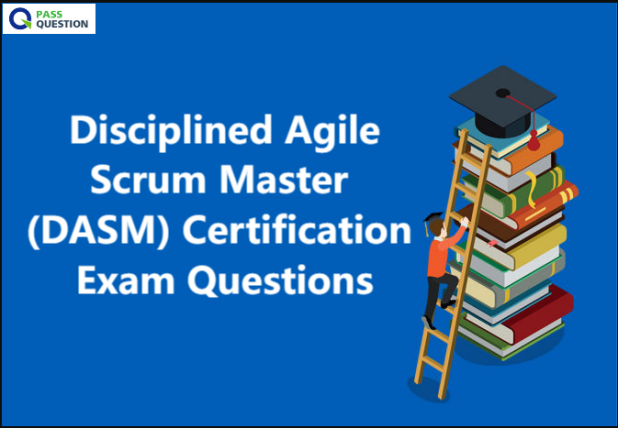Disciplined Agile Scrum Master (DASM) Certification Exam Questions
Are you gearing up for the Disciplined Agile Scrum Master (DASM) certification exam? The Disciplined Agile Scrum Master (DASM) certification is a gateway to mastering agile principles and practices. To help you ace your test, PassQuestion offers the latest Disciplined Agile Scrum Master (DASM) Certification Exam Questions. These practice questions are meticulously designed to align with the exam's objectives, ensuring you're thoroughly prepared for the final test. By practicing with these Disciplined Agile Scrum Master (DASM) Certification Exam Questions, you can familiarize yourself with the format, solidify your knowledge, and boost your confidence for success.

Disciplined Agile Scrum Master (DASM) Certification
The Disciplined Agile Scrum Master (DASM) certification is a valuable credential that equips professionals to work effectively within agile teams by leveraging the comprehensive Disciplined Agile (DA) toolkit. This certification empowers individuals to tailor their approach to problem-solving based on their organization's needs and industry-specific challenges.
Key Features of the DASM Certification
Customizing Your Way of Working (WoW)
- DASM provides the flexibility to adapt agile practices to suit the unique requirements of your organization.
- This certification focuses on practical implementation rather than a one-size-fits-all approach.
Ideal for Beginners and Experienced Professionals
- DASM caters to those starting in agile, as well as seasoned professionals seeking to deepen their understanding.
Exam Details
- Administered through Pearson VUE.
- Non-proctored online test.
- Includes 50 multiple-choice questions.
- Total exam appointment: 120 minutes (90 minutes for the test, 30 minutes for preparation and feedback).
Why DASM Certification?
Do you face challenges like:
- Navigating constantly evolving environments?
- Using rigid frameworks that don't align with your team's needs?
- Feeling your current agile practices fall short of delivering optimal results?
If so, the DASM certification is the solution you’ve been searching for. This certification not only prepares you to lead agile teams confidently but also equips you with future-ready tools to excel in a world increasingly driven by agile methodologies.
The Disciplined Agile Toolkit
The DA toolkit integrates numerous methodologies and practices, including:
- Scrum: Iterative development with a focus on collaboration and feedback.
- Kanban: Visual workflow management for continuous delivery.
- SAFe: Scaled Agile Framework for enterprise-level agility.
By earning the DASM certification, you'll gain the ability to build an agile approach uniquely tailored to your organization's objectives and challenges.
Exam Content Outline
1. Foundations of Agile 30%
- 1.1 Understand the Agile mindset
- 1.2 Differentiate between the iterative ceremonies
- 1.3 Define user stories
2. Foundations of Lean 20%
- 2.1 Understand the principles of Lean
- 2.2 Recognize how to optimize lean delivery
- 2.3 Describe how to learn pragmatically
- 2.4 Understand the team
3. Foundations of Disciplined Agile 24%
- 3.1 Understand the Disciplined Agile mindset
- 3.2 Identify the value proposition of DA
- 3.3 List and describe the 8 principles of DA and when to use them
- 3.4 Classify the DA life cycles and phases
- 3.5 Classify the DA roles within a self-organizing team
- 3.6 Identify goals using the DA toolkit
4. Choose your WoW 26%
- 4.1 Distinguish how people are organized within DA teams
- 4.2 Select your team’s way of working
View Online Disciplined Agile Scrum Master (DASM) Certification Free Questions
1. Which of the following roles would fall under that of a "specialist" on a Disciplined Agile Delivery Team?
A. Business Analyst
B. Product Owner
C. Project Manager
D. Stakeholder
Answer: A
2. What is the Disciplined Agile principle of being pragmatic characterized by?
A. Adapting lean methodologies when necessary
B. Tailoring the organizational structure to the context
C. Identifying when to be agile
D. Being as effective as you can and continuously improving
Answer: D
3. What is the purpose of an iteration retrospective?
A. To showcase what the team accomplished in an iteration.
B. To transfer knowledge and improvements to the next iteration.
C. To prioritize stories and concrete tasks for the next iteration.
D. To identity progress and to note encountered impediments.
Answer: B
4. What is the architecture owner responsible for?
A. Mitigating key technical risks
B. Working cross-functionally to deliver the solution
C. Removing impediments
D. Determining the priorities for the solution
Answer: A
5. What are the three categories of process blades, according to Disciplined Agile (DA)? (Choose three)
A. Disciplined DevOps
B. Disciplined Protect Management Office (PMO)
C. Disciplined Agile IT
D. Disciplined Kanban
E. Disciplined Agile Delivery (DAD)
Answer: A, B, E
6. What arc Disciplined Agile milestones based on?
A. Continuous integration
B. Documentation
C. Lean governance
D. Lifecycle
Answer: C
7. What is the main role of the team lead?
A. Ensure that the team builds the product right.
B. Build the product.
C. Ensure that the team builds the right product.
D. Coordinate the building of the product.
Answer: A
8. The team lead notices that a team member is falling behind on their work.
What would a good Disciplined Agile team lead do?
A. Have a conversation with the team member to better understand what is getting in their way and look for solutions together.
B. Redistribute the team member's work across the team to avoid embarrassing the team member.
C. Have a one-to-one meeting with the team member about their recent failures.
D. Provide time management training to the team member.
Answer: A
9. Which of these tools or techniques should be used to sequence work to deliver value quickly?
A. Minimum business Increment (MBI)
B. Minimum viable product (MVP)
C. Panning Poker
D. Work in process (WIP) limits
Answer: A
10. What is the role of the product owner?
A. Coordinate the product.
B. Inspect the product.
C. Build the right product.
D. Organize the product team.
Answer: C
- TOP 50 Exam Questions
-
Exam
All copyrights reserved 2025 PassQuestion NETWORK CO.,LIMITED. All Rights Reserved.

